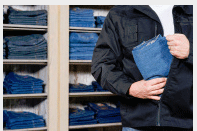 It’s never been more profitable to be a shoplifter. In the past it was difficult to make money from stolen merchandise. A thief commonly used a third party or “fence” to offload the product. Fencing was a secretive, high risk job and “average” shoplifters had no way to establish a connection with one. If they did have one he got a share of the profits, often the biggest cut.
It’s never been more profitable to be a shoplifter. In the past it was difficult to make money from stolen merchandise. A thief commonly used a third party or “fence” to offload the product. Fencing was a secretive, high risk job and “average” shoplifters had no way to establish a connection with one. If they did have one he got a share of the profits, often the biggest cut.
But, the internet has dramatically changed this process. It allows shoplifters to function as their own fence. They’re able to eliminate the middleman and sell directly to, usually, unsuspecting people. Selling stolen goods is easier, safer and more profitable than ever before. Therefore, shoplifting is on the rise and, to stay in business, stores have to be diligent when creating a loss prevention program.
There are 3 main essentials needed for a successful loss prevention program. The 1st and most important is proper store management. This topic is thoroughly discussed in other articles on this site. But, while vital, good management goes only so far. Ultimately, an effective plan also includes 2 other essentials – towers coupled with security labels and hard tags.
Towers are the 2nd essential piece of a successful security plan. Checkpoint System is the leading provider of towers. Checkpoint’s towers are plastic or metal structures and are positioned on both sides of an entrance. They sound an alarm when an active Checkpoint tag or label, which is attached to the merchandise, passes through them. Many shoplifters will by-pass a store with towers and, instead, target one without them.
A 3rd essential is hard tags and labels – Checkpoint has many types of each. Tags are applied to items such as clothing, shoes, and purses; they need a special tool to be removed. Some tags are filled with ink and will open if not properly removed. Labels are attached to things like books, DVDs, cosmetics and are deactivated at the point of sale. When shoplifters see a label or tag, they’ll often move on to merchandise that’s not so well protected.
Making a store a difficult target can keep thieves out of it, which creates a more pleasant, safer environment for employees and shoppers. Just as importantly, Checkpoint can be the difference between staying in business or closing the doors. Checkpoint System, coupled with security savvy management, can go a long way towards producing a profitable store.
Nicole Abbott is a writer and psycho-therapist with over 20 years of experience in the fields of mental health and addiction. She’s an educator, consultant, lecturer, trainer and facilitator, who has conducted over 200 workshops, trainings, presentations, college classes and seminars.







